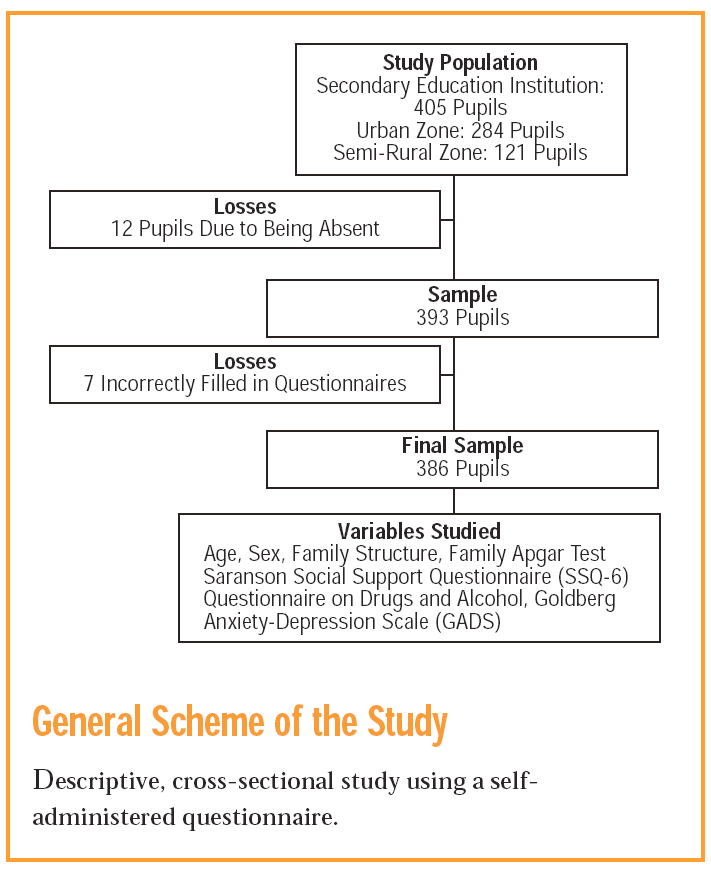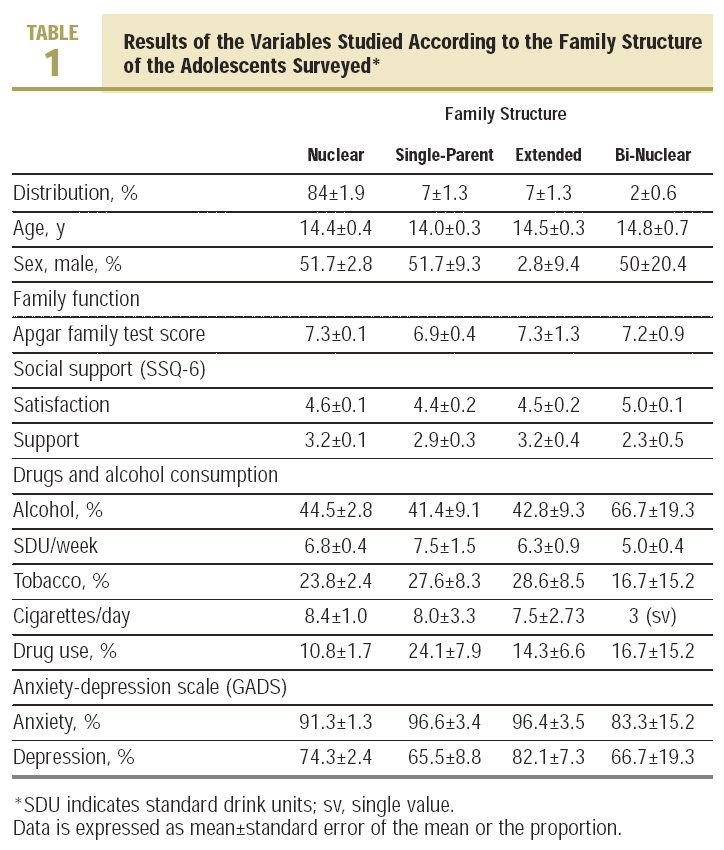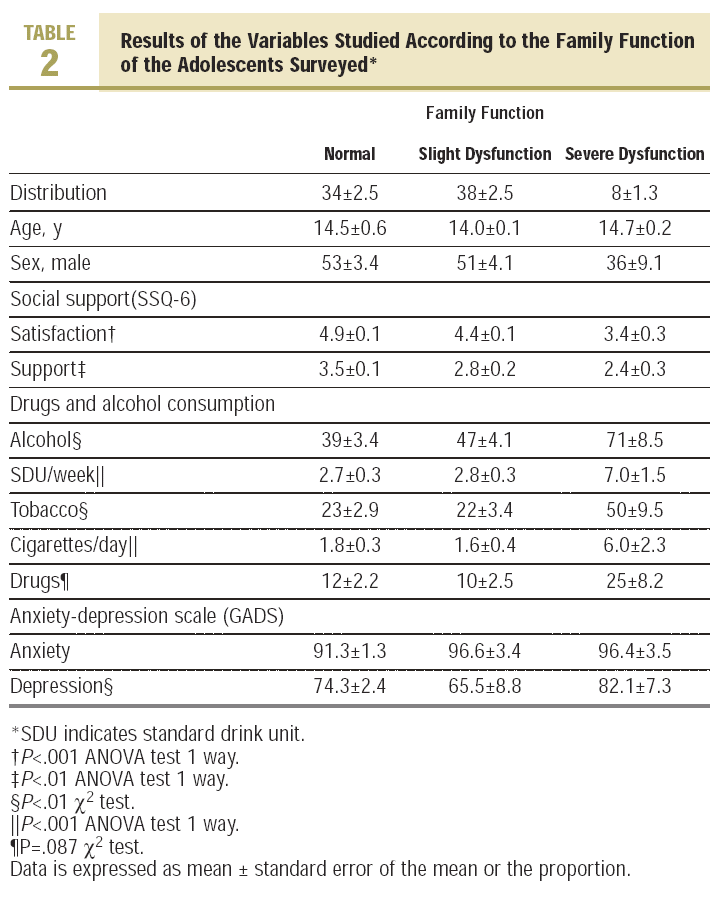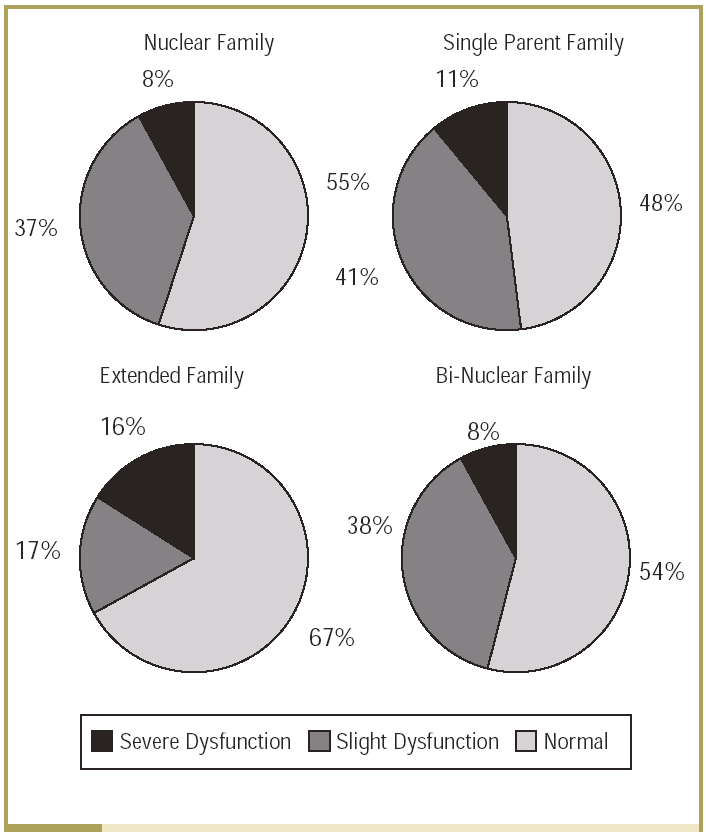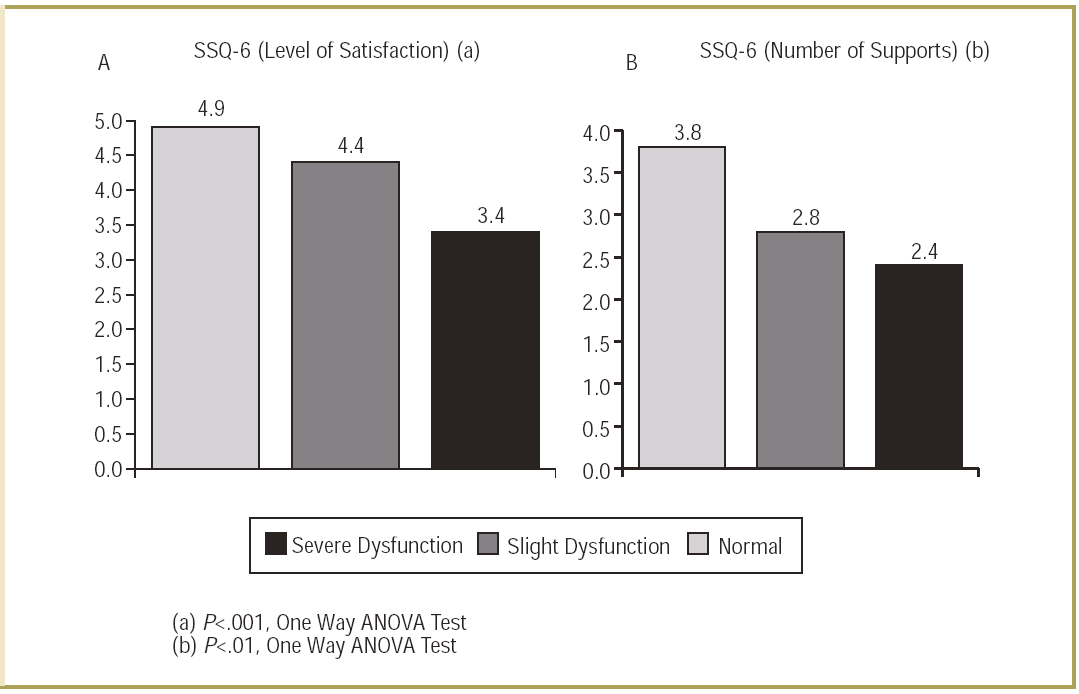Introduction
The family life cycle is defined by the different phases present in the evolution of the family, and is very well defined in western culture.1,2 Adolescence is the third stage in the life of the family and can be a source of tension, due to the great relational complexity between parents and children. The adolescent seeks greater independence and his/her own identity, which begins by using the friends group.3,4 During this transition, the family has to adapt roles and rules to maintain family homeostasis, at the same time as it adapts to the new changes. In this context, the traditional nuclear family appears to be better prepared to cope with the changes and make the correct adjustments.5
This study attempts to find out the family structure of adolescents and how they perceive the functioning of their family, the relationship between both variables and its influence on social support, the consumption of toxic substances, and the feeling of psychic discomfort.
Methods
The study was carried out in 2 secondary education institutions (SEI), one in an urban area and another in a semi-rural area, in a low-medium and medium socioeconomic environment. All the pupils participated by means of a cross-sectional descriptive study using a self-administered and anonymous questionnaire. This was given out on the same school day, after previous training by their teacher.
The variables collected in the questionnaire were age, sex, the composition of the family (who shared the home), and the consumption of drugs and alcohol: standard drink units (SDU) per week, daily cigarette consumption, and contact with illegal drugs. Family function was evaluated by using the Apgar family test,6 which measures the subjective impression that the adolescent has on the functionality of their family, as well as their integration into it. Social support was evaluated using the Saranson questionnaire (SSQ-6),7 which quantifies 2 aspects of social support: availability (are there sufficient people who can help us if needed?, with a range from 0 to 9) and satisfaction (level of satisfaction with existing help, with a range of 0 to 6). Finally, the Goldberg8 anxiety and depression scale was administered, which has fairly high indices of sensitivity and specificity and is able to provide dimensional information on the severity, and is, therefore, recommended as an epidemiological screening tool.
The data were analysed using the Rsigma computer program (Horus Hardware©) and the Kolmogorov-Smirnov test was applied to check the normality of the data. The data are shown as mean ± standard error of the mean or the proportion, and also as 95% confidence intervals. A statistical significance level of P<.05 was proposed and the Student t test and a one way ANOVA were applied to compare the means, and the χ2 test for the comparison of the proportions.
General Scheme of the Study. Descriptive, cross-sectional study using a self-administered questionnaire.
Results
Out of a total of 405 pupils, 386 questionnaires were collected (97% of the total), with 19 lost due to lack of assistance or not filled in correctly. The majority (67%) attended an urban SEI, with comparable results to the questionnaires from the semi-rural area. The mean age was 14.3±0.3 years (range, 12-17 years), with 51% male and 49% females. The most common family structure was nuclear (88%±1.9%) (Table 1) and 55%±2.5% of the adolescents perceived that their family functioned well (Table 2), with a mean Apgar family test score of 7.3±0.1.
Slight family dysfunction was more common (38%±2.5%) than the severe (7%±1.3%) and had a similar distribution, independent of the type of family structure of the adolescent (Figure 1). Family structure and function were not related to age or sex (Tables 1 and 2).
FIGURE 1. Adolescent perception of family function according to the type of family structure.
Social support had similar means, independent of the family structure, with a level of satisfaction of 4.6±0.1 out of 9 and the number of supports, 3.1±0.1 out of 6 (Table 1). There was a positive association between the scores obtained in the Apgar family test and the SSQ-6: the adolescents who perceived a normal family function had more social support (Figure 2 and Table 2).
FIGURE 2. Relationship between values obtained in the Saranson social support questionnaire (SSQ-6) according to family functioning of the adolescent.
44%±2.5% drank alcohol, with a mean quantity of 6.8±0.4 SDU consumed per week. Approximately one quarter (24%±2.2%) smoked a mean of 8.2±0.9 cigarettes daily and 12±1.7 had consumed illegal drugs. There are small differences according to family structure but they were not statistically significant (Table 1). Family structure did influence the consumption of toxic substances: in the adolescent group with intense family dysfunction there was a significant increase in alcohol consumption, both qualitative (27%±6.4%; P<.01, χ2 test) and quantitative (4.3±0.9 SDU more per week; P<.001, ANOVA test), as well as tobacco, qualitative 32%±5.9%; P<.001, χ2 test) and quantitative (a difference of 4.3±1.4 cigarettes/day; P<.001, ANOVA test) (Table 2).
It was observed that up to 92%±1.4% adolescents had symptoms indicative of anxiety on the Goldberg scale, which was more common among females (95%±1.6%) than among males (89%±2.2%; P<.05, χ2 test). Three quarters of those surveyed showed depressive (74%±2.2%), which is more frequent in older adolescents (mean age with symptoms: 14.7±0.5 years; without symptoms 13.6±0.1 years; P<.05, Student t test) and among those who perceive a poorly functioning family (P<.01, χ2 test) (Table 2).
Discussion
Adolescence is a stage when the changes take place that are necessary for the young people to adapt to their body changes, to acquire their own identity and begin their socialisation process.9
A well functioning family unit helps to make adapting to these changes easier2 and it has been associated with the structure of the family: the nuclear type family may be more prepared to face up to the changes in each phase of their life cycle,1,2,5 while other family patterns may be associated with several problems appearing during adolescence.5
Our data, on the other hand, show that the family structure does not influence the perception that the adolescence has on the functioning level of the family, or in the feeling of social support, consumption of toxic substances or in the presence of symptoms indicative of psychic discomfort. These results may require us to redefine traditional concepts: on the one hand, the nuclear family does not seem to be essential to establish positive family relationships and a healthy psychological development in the adolescent.2 On the other hand, family dynamics could be influenced by other demographic factors and available resources1 more than by the family structure: non-nuclear families may have alternative life cycles that bestows normal functioning.10
In our study we see that the perception of family support by the adolescent is associated with social support.6,11 Friends are an object of reference as regards the rules and values for the adolescent, but if they feel that they are accepted and listened to within the home, their social network improves and their socialisation process can be completed more satisfactorily.3,12 Inadequate social support in adolescence has been associated with unsettling behaviour such as violence.13
Family function and social support are also associated with the consumption of toxic substances among adolescents14,15: in our study there was a significant increase in alcohol and cigarette consumption in adolescents with severe family dysfunction. Lastly, although the majority of adolescents mention good physical health,16,17 there is a high presence of symptoms indicative of psychic discomfort18 and there is an association between family dysfunction and depressive symptoms. In the general population, psychic discomfort decreases the quality of life and has a negative influence on social support, contact with family, and coping with stressful life events.19 We could, therefore, establish a relationship between a poor functioning family, poor social support, low perception of health and major stress.7,20,21 Other studies carried out in the same area showed that adolescents who visit their doctor regularly are more likely to have a dysfunctioning family, psychic discomfort and/or use toxic substances.17
While family dysfunction in the general population varies between 16% and 35%,6,22,23 in our study almost 50% of adolescents were not content with how their family functioned. This fact is not shared by the parents in 90% of families, who believe that they have satisfactory communication with their adolescent children.24 Adolescence is a life crisis period, but one that can be useful to achieve a better family cohesion.11,12 Given that family dysfunction and its association with other psychosocial factors, health and education professionals are in an exceptional position to offer individual assessment by means of participatory counselling3,10 and try to improve communication between family members, with the aim of achieving a significant "experiential appeal" with which the adolescent might adjust to a healthy environment.11 In short, it is about promoting a healthy and balanced growing up in the adolescent, by means of a multidisciplinary intervention that is based on developing good family and social support, as well as improving communication with their parents.
What Is Known About the Subject
* Adolescence is a period of change in the family rules and roles and all members have to adapt.
* The family structure influences its functionality and the nuclear family is best prepared to face up to the changes.
* Friends of the adolescent fulfil a fundamental role in their socialisation.
What This Study Contributes
* Structure does not influence the family functionality as perceived by the adolescent.
* Family support is essential so that the adolescent obtains satisfactory social support.
* Severe family dysfunction in adolescence is associated with a higher number of depressive symptoms and a higher consumption of alcohol, tobacco, and possibly other drugs.
Manuscript received November 8, 2005.
Manuscript accepted for publication May 15, 2006.
The contents of this study were partially presented as an open presentation at the XV SAMFYC Congress held in Huelva (2-4 June 2005) and awarded the prize for the best poster by the Scientific Committee.
Spanish version available at www.atencionprimaria.com/143.044
A commentary follow this article (page 66)
Correspondence:
Dr. A. Pérez Milena.
Travesía de San Joaquín, 6, 3.º dcha. 23007 Jaén. España.
E-mail: alejandropm@supercable.es





